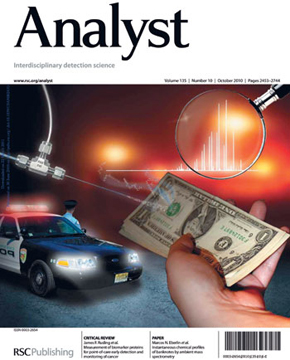
The October cover, with the article on the Easi technique
An article produced by the Institute of Chemistry of the State University of Campinas (IQ/Unicamp) about a new mass spectrometry technique and its use for checking the authenticity of documents and bank notes was the cover story of the journal, Analyst, by the UK’s Royal Society of Chemistry, in October 2010. In November it was featured in Pesquisa FAPESP. Now it has entered Analyst’s hot 5 list, which means that it was among the five most accessed articles last year on the website of the publication that specializes in analytical chemistry. “As two of the five papers are reviews and do not count, because they are naturally the most read, our work was among the three most attractive in 2010”, celebrates chemist, Marcos Eberlin, founder and coordinator of IQ/Unicamp’s ThoMSon Laboratory of Mass Spectrometry.
Presenting an annual list of the scientific articles that are of most interest to readers is a common practice of foreign journals. With on-line texts it is easy to know how many times each of them just read a summary and how many people really download the whole article. Being part of the select group of the five most accessed articles during the year in a journal with a great tradition and high impact like the Analyst is also encouraging because it will probably have an influence on the number of times the read work is cited. “But it’s not possible to be sure. You need to wait from five to ten years to get the final result. Although the expectation that the article will be much cited by other researchers is positive,” says Eberlin. Another interesting factor is that the article was accessed as from October, in other words, in the final months of the year.
The studies provided by the Easi-MS (Easy Ambient Sonic-Spray Ionization Mass Spectrometry) technique, created by Eberlin in 2006, have been recognized in the scientific world. Thirty articles have already been produced and in 2010 alone the team from Unicamp published eleven of them in international journals, like Analyst, Analytical Chemistry and Analytical & Bioanalytical Chemistry. The work that is among the five most popular shows how Easi was effective in differentiating false Brazilian real, euro and US dollar bank notes from real ones. The result is immediate, while normal analysis techniques take days and demand highly qualified personnel. The method is part of a new generation of mass spectrometry techniques that are capable of simply identifying and quantifying each type of molecule in complex mixtures and discriminating which atoms form these molecules and how they are arranged. The speed, simplicity and accuracy with which inks, printed material, beverages and falsified oil derivatives can be identified led the Federal and Civil Police to sign agreements with the IQ/Unicamp laboratory.
Eberlin says that the situation was unimaginable 20 years ago. “We used to go abroad and we were astonished with the resources and structure of the laboratories, while at IQ, for example, there were just one or two pieces of old equipment for identifying molecules”, he recounts. Today there are more than 20 of them in the institute, which is among the best and most up-to-date in the world. “In two decades we turned the game around, from being spectators to being leaders in science and technology, thanks to the investment of FAPESP and, at least in analytical chemistry, we’ve managed to publish in quantity and quality in the best journals in the world”, he says.
Republish